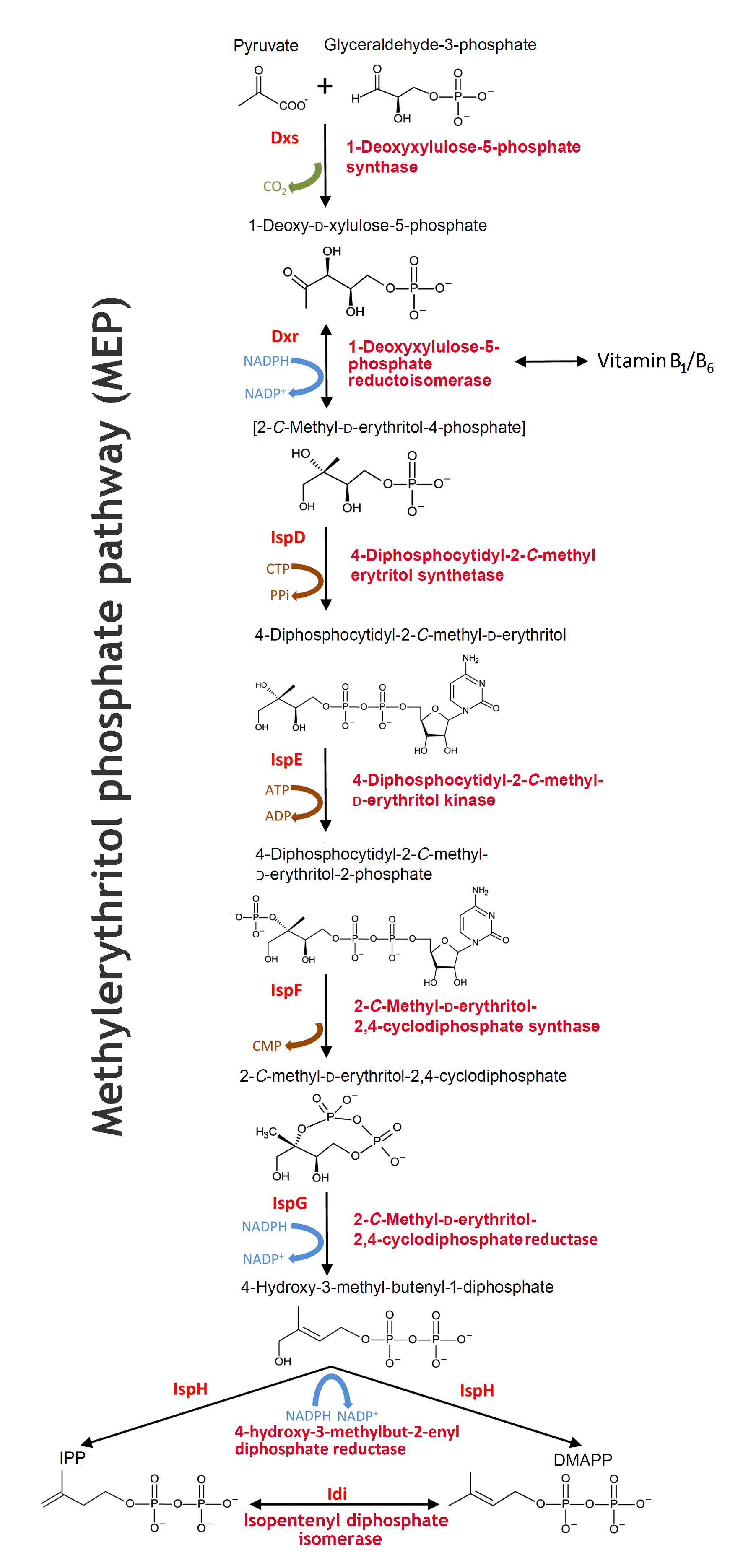Team:SDU-Denmark/Tour31
From 2013.igem.org
Specifications
Rewiring the E. coli machinery
As mentioned, the nonpathogenic E. coli strain MG1655 only lacks the prenyltransferase enzyme from the rubber tree before it is able to produce natural rubber. Apart from introducing the HRT2 gene to the strain, we also wanted to enhance the IPP production of the cell for further rubber production. As a consequence of these goals, we studied the prenyltransferase and the MEP pathway, which subsequently enabled us to reach our rubber-producing ambitions.
MEP pathway
The biosynthesis of isoprenoids in bacteria works through the MEP pathway. MEP pathwaymethylerythritol phosphate pathway
- The pathway is initiated with a condensation reaction between GAP GAPD-glyceraldehyde-3-phosphate and pyruvate to produce DXP DXP1-deoxy-D-xylulose-5-phosphate and CO2 catalysed by Dxs. DXS1-deoxyxylulose-5-phosphate synthase
- DXP is reductively isomerized to MEP MEP2-C-methyl-D-erythritol-4-phosphate by Dxr Dxr1-deoxy-D-xylulose-5-phosphate reductoisomerase in a reversible NADPH-dependent reaction
- This is subsequently converted to CDP-ME CDP-ME4-diphosphocytidyl-2-C-methyl-D-erythritol in a CTP substrate inhibited reaction catalysed by IspD. IspD4-diphosphocytidyl-2-C-methyl-D-erythritol synthase DXP is not only a substrate in the isoprenoids biosynthesis, but also for the reversible synthesis of B1-vitamin and further synthesis of B6-vitamin in the thiamine biosynthesis pathway.
- The next step in the MEP pathway is an ATP-dependent phosphorylation of the C2 hydroxyl group of CDP-ME, giving CDP-MEP CDP-MEP4-diphosphocytidyl-2-C-methyl-D-erythritol-2-phosphate catalysed by IspE. IspE4-diphosphocytidyl-2-C-methyl-D-erythritol kinase
- CDP-MEP is cyclized to MEcPP MEcPP2-C-methyl-D-erythritol-2,4-cyclodiphosphat by IspF IspF2-C-methyl-D-erythritol-2,4-cyclodiphosphate synthase and in the next reaction IspG IspG1-hydroxy-2-methyl-2-(E)-butenyl 4-diphosphate synthase catalyzes the ring opening of the cyclic pyrophosphate and subsequent C3-reductive dehydration of MEcPP to HMBPP. HMBPP1-hydroxy-2-methyl-2-(E)-butenyl 4-diphosphate
- The MEP pathway’s final step, the conversion of HMBPP to IPP IPPisopentenyl diphosphate and DMAPP DMAPPdimethylallyl diphosphate, is catalysed by IspH. IspH4-hydroxyl-3-methyl-butenyl-1-disphosphate reductase
There exists a natural equilibrium between the two isomers IPP and DMAPP. The enzyme Idi Idiisopentenyl diphosphat isomerase catalyses the reversible isomerization reaction between IPP and DMAPP in order to balance the ratio of IPP and DMAPP according to the cellular demands under various conditions. Source: Lishan Zhao, Wei-chen Chang, Youli Xiao, Hung-wen Liu and Pinghua Liu: Methylerythritol Phosphate Pathway of Isoprenoid Biosynthesis, Annu. Rev. Biochem. 2013. 82:497-530, page 500. (Link)
In our system this will cause dislocation of the equilibrium towards IPP production, since IPP is the five carbon building block in the rubber biosynthesis. In accordance, the reversible formation of B1-vitamin from DXP will be dislocated towards the production of DXP rather than B1-vitamin (See our model).
 An illustration of the rubber synthesis.
An illustration of the rubber synthesis.
Polyprenyltransferase
When used for rubber production in E. coli, the MEP pathway is followed by a prenyltransferase catalysed rubber polymerisation reaction, where one IPP molecule condenses with DMAPP followed by condensation products:
GPP GPPgeranyl diphosphate, C10,
FPP FPPfarnesyl diphosphate, C15 and
GGPP etc.GGPPgeranylgeranyl diphosphate, C20
In Hevea brasiliensis, the rubber polymerisation reaction is catalysed by a cis-1,4-polyprenyltransferase known as
Hevea Rubber Transferase 2 (HRT2).
Source:
Alexander Steinbüchel: Production of rubber-like polymers by microorganism, Current Opinion in Microbiology 2003. 6:261-270. (book) (Link)
Note: Ecocyc noted that overexpression of Dxs results in increased isoprenoid biosynthesis, but also yields a reduced growth rate for the whole cell. Ecocycs reference
 "
"
 The MEP pathway - Will open in a new tab due to the size. Edited from Alexander Steinbüchel: Production of rubber-like polymers by microorganism, Current Opinion in Microbiology 2003. 6:261-270.
The MEP pathway - Will open in a new tab due to the size. Edited from Alexander Steinbüchel: Production of rubber-like polymers by microorganism, Current Opinion in Microbiology 2003. 6:261-270.